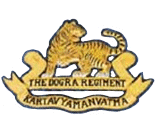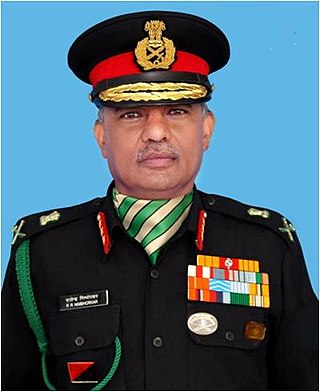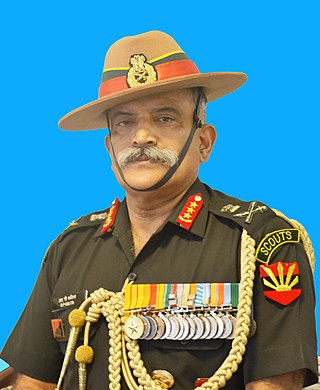
The Dogra Regiment is an infantry regiment of the Indian Army. The regiment traces its roots directly from the 17th Dogra Regiment of the British Indian Army. When transferred to the Indian Army like its sister regiments, the numeral prefix was removed. Units of the Dogra Regiment have fought in all conflicts that independent India has been engaged in, making it one of the most prestigious and most decorated regiments of the Indian Army.

The Parachute Regiment is an airborne and special forces regiment of the Indian Army. It was raised in 1945 as part of the British Indian Army but was disbanded after World War II and was re-raised in 1952 as part of the Indian Army. Currently it consists of fifteen Special Forces, two Territorial Army and one Rashtriya Rifles battalions.

The Kumaon Regiment is one of the oldest infantry regiments of the Indian Army. The regiment traces its origins to the 18th century and has fought in every major campaign of the British Indian Army and the Indian Army, including the two world wars, and is one of the highest decorated regiments of the Indian Army.

The Poona Horse is an armoured regiment in the Armoured Corps of the Indian Army. The regiment, known before independence as The Poona Horse, was raised as a regular cavalry regiment in the Bombay Presidency army of the East India Company. It was formed from the 3rd Regiment of Bombay Light Cavalry, raised in 1820, and the Poona Auxiliary Horse, raised about 1817–18. The latter unit was absorbed into the regular forces about 1860 and the two regiments later became the 33rd Queen Victoria's Own Light Cavalry and the 34th Prince Albert Victor's Own Poona Horse.

The Garhwal Rifles, formerly known as the Royal Garhwal Rifles, are an infantry regiment of the Indian Army. It was originally raised in 1887 as the 39th (Garhwal) Regiment of the Bengal Army. It then became part of the British Indian Army, and after the Independence of India, it was incorporated into the Indian Army.

General Dalbir Singh Suhag, PVSM, UYSM, AVSM, VSM, ADC is the former Indian High Commissioner to Seychelles and a former Chief of Army Staff of the Indian Army. He was the 25th Chief of the Army Staff (COAS) of the Indian Army, serving from 31 July 2014 to 31 December 2016, and Vice Chief of the Army Staff prior to that.

Lieutenant General Praveen Bakshi PVSM, AVSM, VSM, ADC was the 25th General Officer-Commanding-in-Chief Eastern Command of the Indian Army and assumed office on 1 August 2015 after Lieutenant General Man Mohan Singh Rai.

Lieutenant General Rajendra Ramrao Nimbhorkar, PVSM, UYSM, AVSM, SM**, VSM is a former officer of the Indian Army who served as the Master General Ordnance (MGO). He assumed office on 9 August 2017 after Lieutenant General Ravi Thodge retired. He was part of one of the strike corp which was responsible for carrying out three strikes inside POK in Surgical Strikes held in 2016 by the Indian Army to clean out all the Pakistani Terrorists Camps. As surgical strikes were carried out very secretly to maintain surprise, so very few people knew of them, one of those involved was Lt. Gen. Nimbhorkar.

Admiral Radhakrishnan Hari Kumar is retired flag officer in the Indian Navy. He served as 25th Chief of the Naval Staff (CNS). Previously, he served as the Flag Officer Commanding-in-Chief, Western Naval Command. In his prior appointments, he served as the Chief of Integrated Defence Staff, Chief of Personnel, Controller Personnel Services, the Flag Officer Commanding Western Fleet, Flag Officer Sea Training and the Chief of the Staff of the Western Naval Command. He was the Commandant of the Naval War College, Goa and served as a naval advisor to the government of Seychelles. He is an alumnus of National Defence Academy, the Naval War College, the Army War College, Mhow and the Royal College of Defence Studies.

Lieutenant General (Dr) Jaiveer Singh Negi PVSM, AVSM, YSM, VSM** is a retired General Officer who has served as the 49th Commandant of the Indian Military Academy. He took over from Lieutenant General Sanjay Kumar Jha, PVSM, AVSM, YSM, SM, on 1 February 2020. Prior to his appointment as Commandant of the Indian Military Academy, he was the Deputy Commander-in-Chief of Strategic Forces Command

Lieutenant General Harinder Singh PVSM, AVSM, YSM, SM, VSM, is a retired General Officer of the Indian Army. He retired from Indian Army after serving as commandant of Indian Military Academy in his last appointment. Previously, he was the Commander of XIV Corps from October 2019 to October 2020, succeeding Lt Gen Yogesh Kumar Joshi, PVSM, UYSM, AVSM, VrC, SM, ADC.
26 Air Defence Regiment is an Air Defence regiment of the Indian Army.
Major General Dalvir Singh AVSM, VrC, VSM is a retired Indian Special Forces officer, a former General Officer of the Indian Army and the recipient of Vir Chakra, India's third-highest War-time gallantry award. He has commanded the 10th Battalion Special Forces, the elite 52 Special Action Group of the NSG, Kilo Force of the Rashtriya Rifles and the Territorial Army (India), with distinction. After retirement from active military service, he has been serving as the Director Training of Rajasthan Police Training Center Jodhpur.

Air Marshal Manavendra Singh, PVSM, AVSM, VrC, VSM, ADC is a retired officer of the Indian Air Force. He served as the Air Officer Commanding-in-Chief (AOC-in-C), Training Command. He assumed the office on 25 September 2021 succeeding Air Marshal Rajiv Dayal Mathur. Previously, he served as Air Officer Commanding-in-Chief, Southern Air Command.
79 Medium Regiment is part of the Regiment of Artillery of the Indian Army.

Lieutenant General Rana Pratap Kalita, PVSM, UYSM, AVSM, SM, VSM is a former general officer in the Indian Army. He served as the General Officer Commanding-in-Chief (GOC-in-C) of the Indian Army's Eastern Command. He previously commanded the III Corps at Dimapur.
195 Medium Regiment (Banwat) is part of the Regiment of Artillery of the Indian Army.
90 Field Regiment is part of the Regiment of Artillery of the Indian Army.
94 Field Regiment is part of the Regiment of Artillery of the Indian Army.












